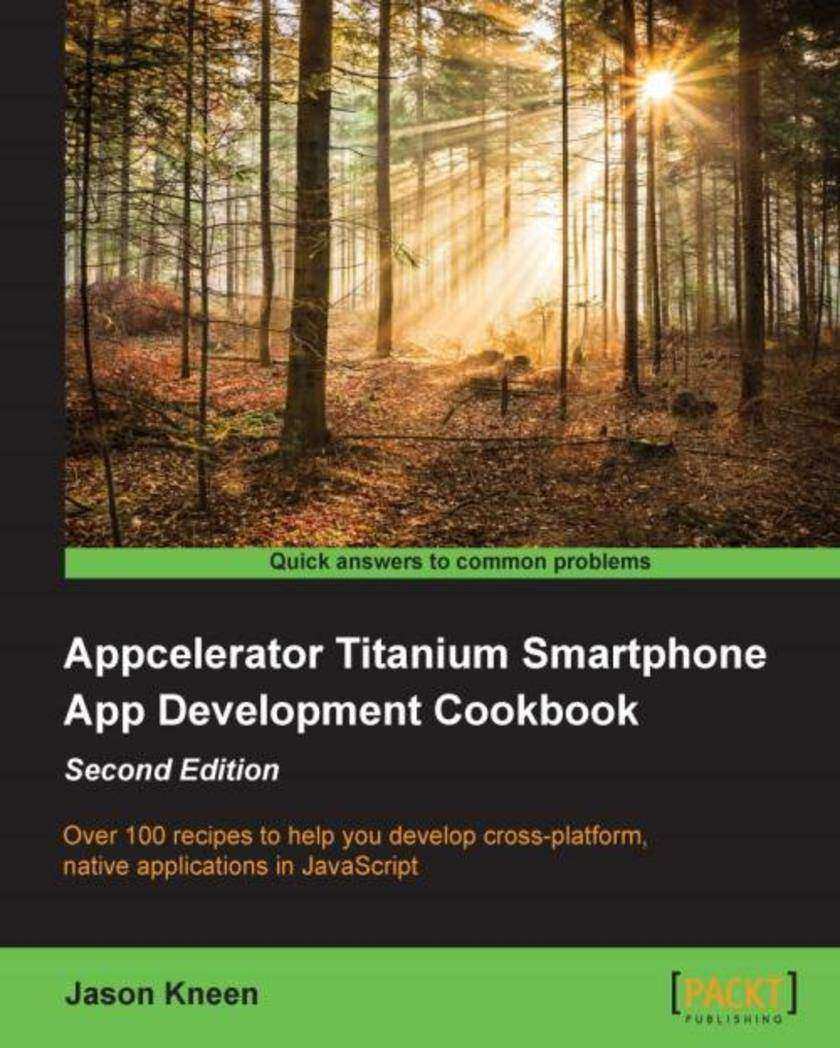
Appcelerator Titanium Smartphone App Development Cookbook - Second Edition
¥80.65
Over 100 recipes to help you develop cross-platform, native applications in JavaScript About This Book Leverage your JavaScript skills to write mobile applications using Titanium Studio tools with the native advantage Deploy your application on the App Store and Google Play Add your own IOS native modules in objective-C, in an easy-to-follow step-by-step format Who This Book Is For This book is an essential for any developer learning or using JavaScript who wants to write native UI applications for iOS and Android. No knowledge of Objective-C, Swift and Java is required and you’ll quickly be developing native, cross-platform apps, in JavaScript! What You Will Learn Transfer data between applications with URL schemes, and make your application accessible to other mobile applications and services Connect with remote services using JSON Work with Google Maps and Apple Maps, GPS and annotate routes Create animations and special effects Integrate notifications and connect with social media services such as Facebook and Twitter Build applications with Alloy MVC – a rapid application development framework Design native APIs and use local databases In Detail The mobile web has paved the way but many users want to have “native” applications installed. Using Appcelerator as a platform it’s now possible to write iOS, Android, and Windows phone applications in JavaScript! It allows developers to develop fully native UI applications using Appcelerator studio tools without any knowledge of Objective-C, Swift or Java. This book will take you through the process of building cross-platform, native UI applications for the mobile from scratch. You will learn how to develop apps, how to use GPS, cameras and photos and how to build socially connected apps. You will also learn how to package them for submission to the App Store and Google Play. This cookbook takes a pragmatic approach to creating applications in JavaScript from putting together basic UIs, to handling events and implementation of third party services such as Twitter, Facebook and Push notifications. The book shows you how to integrate datasources and server APIs, and how to use local databases. The topics covered will guide you to use Appcelerator Studio tools for all the mobile features such as Geolocation, Accelerometer, animation and more. You’ll also learn about Alloy, the Appcelerator MVC framework for rapid app development, and how to transfer data between applications using URLSchemes, enabling other developers to access and launch specific parts of your app. Finally, you will learn how to register developer accounts and publish your very own applications on the App Store and Google Play. Style and approach This book offers a set of practical recipes with a step-by-step approach for building native applications for both the iOS and Android using JavaScript. This hands-on guide shows you exactly how to use the Appcelerator platform to rapidly develop cross-platform, native apps.
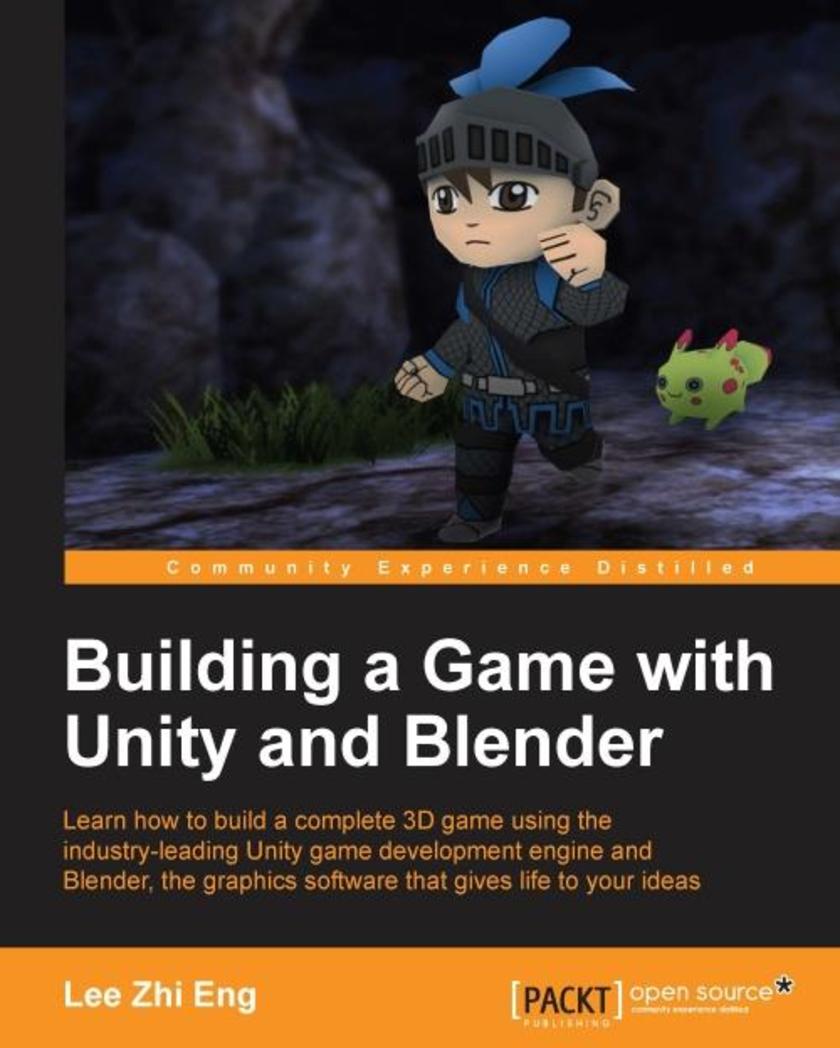
Building a Game with Unity and Blender
¥80.65
Learn how to build a complete 3D game using the industry-leading Unity game development engine and Blender, the graphics software that gives life to your ideas About This Book Learn the fundamentals of two powerful tools and put the concepts into practice Find out how to designand buildall the core elements required for a great game - from characters to environments, to props— Learn how to integrate Artificial Intelligence (AI) into your game for sophisticated and engaging gameplay Who This Book Is For This book has been created for anyone who wants to learn how to develop their own game using Blender and Unity, both of which are freely available, yet very popular and powerful, tools. Not only will you be able to master the tools, but you will also learn the entire process of creating a game from the ground up. What You Will Learn Design and create a game concept that will determine how your game will look and how it will be played Construct 3D models of your game characters and create animations for them before importing them into the game Build the game environment from scratch by constructing the terrain and props, and eventually put it all together to form a scene Import and integrate game assets created in Blender into Unity—for example, setting up textures, materials, animation states, and prefabs Develop game structures including a game flow, user interface diagram, game logic, and a state machine Make the game characters move around and perform certain actions either through player inputs or fully controlled by artificial intelligence Create particles and visual effects to enhance the overall visual aesthetic Deploy the game for various types of platforms In Detail In the wake of the indie game development scene, game development tools are no longer luxury items costing up to millions of dollars but are now affordable by smaller teams or even individual developers. Among these cutting-edge applications, Blender and Unity stand out from the crowd as a powerful combination that allows small-to-no budget indie developers or hobbyists alike to develop games that they have always dreamt of creating. Starting from the beginning, this book will cover designing the game concept, constructing the gameplay, creating the characters and environment, implementing game logic and basic artificial intelligence, and finally deploying the game for others to play. By sequentially working through the steps in each chapter, you will quickly master the skills required to develop your dream game from scratch. Style and approach A step-by-step approach with tons of screenshots and sample code for readers to follow and learn from. Each topic is explained sequentially and placed in context so that readers can get a better understanding of every step in the process of creating a fully functional game.
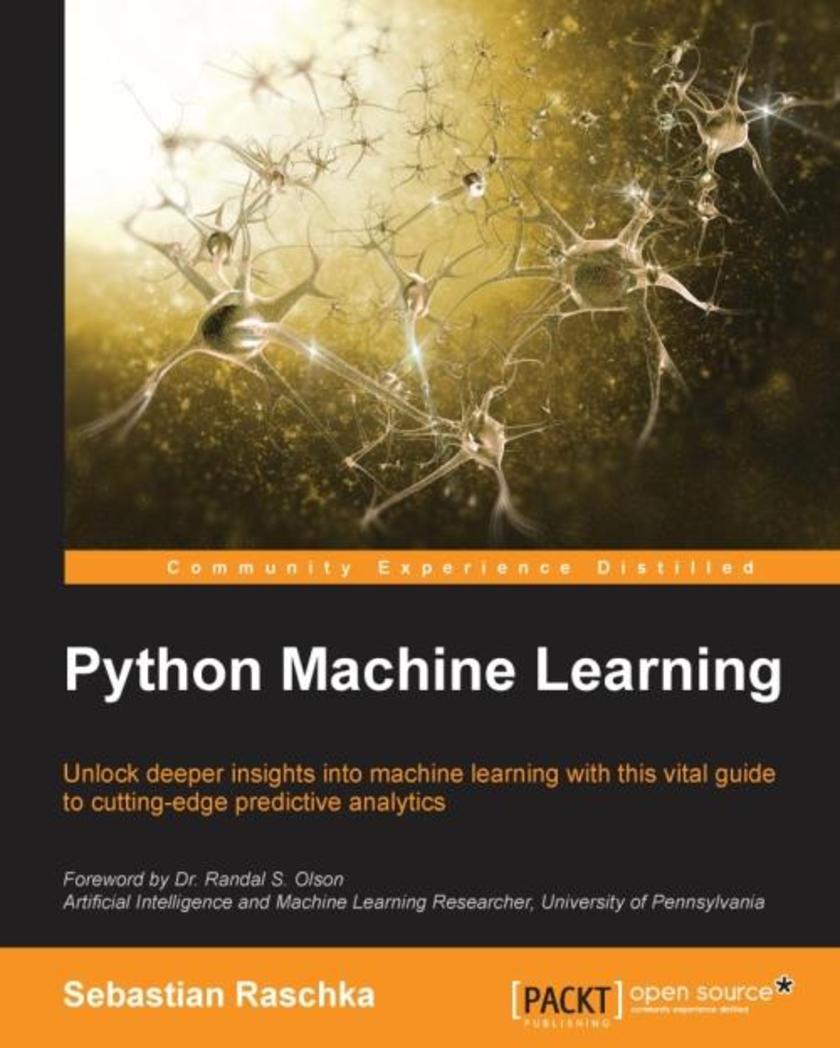
Python Machine Learning
¥80.65
Unlock deeper insights into Machine Leaning with this vital guide to cutting-edge predictive analytics About This Book Leverage Python’s most powerful open-source libraries for deep learning, data wrangling, and data visualization Learn effective strategies and best practices to improve and optimize machine learning systems and algorithms Ask – and answer – tough questions of your data with robust statistical models, built for a range of datasets Who This Book Is For If you want to find out how to use Python to start answering critical questions of your data, pick up Python Machine Learning – whether you want to get started from scratch or want to extend your data science knowledge, this is an essential and unmissable resource. What You Will Learn Explore how to use different machine learning models to ask different questions of your data Learn how to build neural networks using Keras and Theano Find out how to write clean and elegant Python code that will optimize the strength of your algorithms Discover how to embed your machine learning model in a web application for increased accessibility Predict continuous target outcomes using regression analysis Uncover hidden patterns and structures in data with clustering Organize data using effective pre-processing techniques Get to grips with sentiment analysis to delve deeper into textual and social media data In Detail Machine learning and predictive analytics are transforming the way businesses and other organizations operate. Being able to understand trends and patterns in complex data is critical to success, becoming one of the key strategies for unlocking growth in a challenging contemporary marketplace. Python can help you deliver key insights into your data – its unique capabilities as a language let you build sophisticated algorithms and statistical models that can reveal new perspectives and answer key questions that are vital for success. Python Machine Learning gives you access to the world of predictive analytics and demonstrates why Python is one of the world’s leading data science languages. If you want to ask better questions of data, or need to improve and extend the capabilities of your machine learning systems, this practical data science book is invaluable. Covering a wide range of powerful Python libraries, including scikit-learn, Theano, and Keras, and featuring guidance and tips on everything from sentiment analysis to neural networks, you’ll soon be able to answer some of the most important questions facing you and your organization. Style and approach Python Machine Learning connects the fundamental theoretical principles behind machine learning to their practical application in a way that focuses you on asking and answering the right questions. It walks you through the key elements of Python and its powerful machine learning libraries, while demonstrating how to get to grips with a range of statistical models.
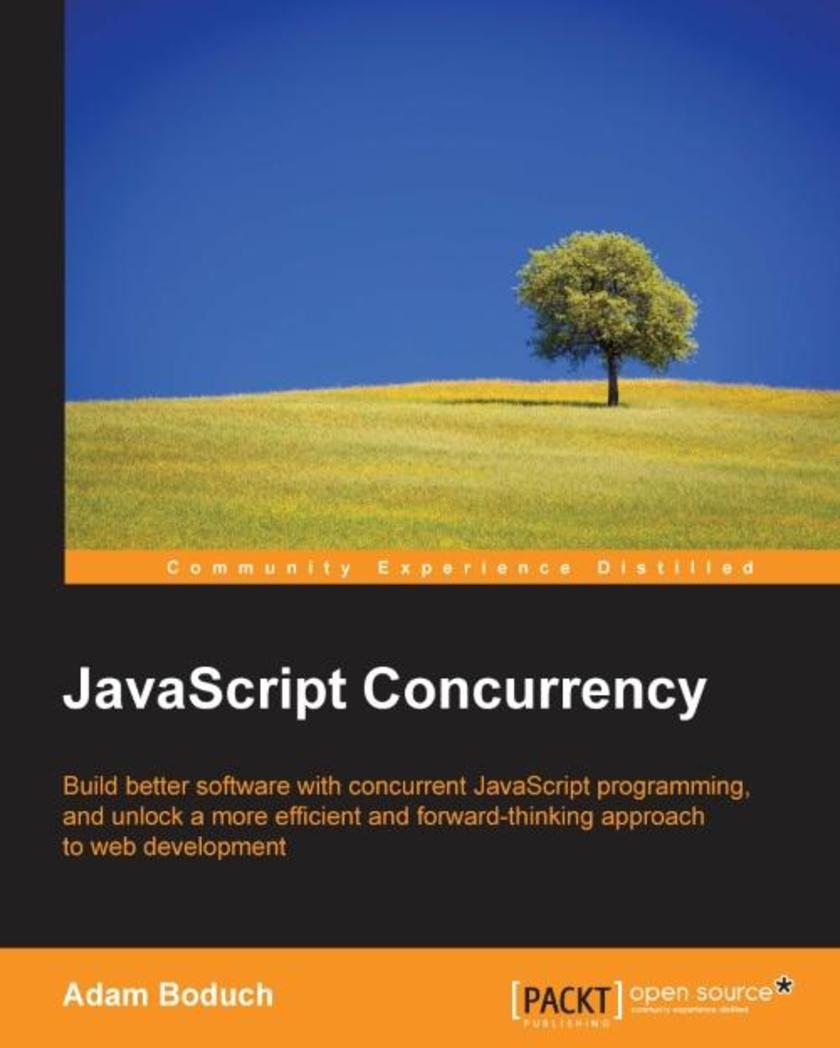
JavaScript Concurrency
¥80.65
Build better software with concurrent JavaScript programming, and unlock a more efficient and forward thinking approach to web development About This Book Apply the core principles of concurrency to both browser and server side development Explore the latest tools and techniques at the forefront of concurrent programming, including JavaScript promises, web workers, and generators Learn how concurrent and parallel programming can help you tackle the challenges of fast, data heavy web development Who This Book Is For JavaScript Concurrency is written for any JavaScript developer who wants to learn how to write more efficient, powerful, and maintainable applications that utilize the latest developments in the JavaScript language. All aspects of concurrent, asynchronous, and parallel programming are covered from first principles and by the end of the book you’ll be able to create a fully-worked application that leverages all the topics covered in the book. What You Will Learn Understand exactly how JavaScript works in a web browser environment, and how these mechanisms power our event-driven JavaScript code Use promises to turn complex synchronization scenarios into readable and maintainable values Compute values lazily and avoid unnecessary memory allocations using generators. Write concurrent code that doesn’t feel like concurrent code by abstracting away boilerplate chores Leverage true hardware parallelism with web workers to get a better performance Get to grips with the NodeJS model of concurrency and learn why it’s good for I/O-intensive web applications In Detail Concurrent programming may sound abstract and complex, but it helps to deliver a better user experience. With single threaded JavaScript, applications lack dynamism. This means that when JavaScript code is running, nothing else can happen. The DOM can’t update, which means the UI freezes. In a world where users expect speed and responsiveness – in all senses of the word – this is something no developer can afford. Fortunately, JavaScript has evolved to adopt concurrent capabilities – one of the reasons why it is still at the forefront of modern web development. This book helps you dive into concurrent JavaScript, and demonstrates how to apply its core principles and key techniques and tools to a range of complex development challenges. Built around the three core principles of concurrency – parallelism, synchronization, and conservation – you’ll learn everything you need to unlock a more efficient and dynamic JavaScript, to lay the foundations of even better user experiences. Throughout the book you’ll learn how to put these principles into action by using a range of development approaches. Covering everything from JavaScript promises, web workers, generators and functional programming techniques, everything you learn will have a real impact on the performance of your applications. You’ll also learn how to move between client and server, for a more frictionless and fully realized approach to development. With further guidance on concurrent programming with Node.js, JavaScript Concurrency is committed to making you a better web developer. The best developers know that great design is about more than the UI – with concurrency, you can be confident every your project will be expertly designed to guarantee its dynamism and power. Style and approach Beginning with the fundamentals of concurrency and how they apply to JavaScript development, the book then takes you through the relevant constructs that will help you implement concurrent code. You’ll learn how even the most abstract and theoretical aspects of concurrent programming help you solve real world challenges, with clear and practical demonstrations that show you how concurrent JavaScript will make you a better developer.

GameMaker Cookbook
¥80.65
Over 50 hands-on recipes to help you build exhilarating games using the robust GameMaker system About This Book Design and develop game elements that can be used alone or stacked to enhance your gaming experience Explore extensions that can unlock GameMaker: Studio’s true potential to create complex games A recipe-based, easy-to-follow guide to take your GameMaker skills to the next level Who This Book Is For This book is intended for GameMaker: Studio enthusiasts who are looking to add more substance and improve their content. If know your way around the program and have some basic GML skills but want to take them further, then this book is for you. What You Will Learn Set up player control schemes of various types, such as touch controls and a gamepad Create your own physics sandbox Get accustomed to advanced player movement Implement music and 3D sound in your games Utilize GameMaker’s GUI layers to create exciting games Generate adjustable game settings and save systems Add depth to your game with lighting and special effects In Detail GameMaker: Studio started off as a tool capable of creating simple games using a drag-and-drop interface. Since then, it has grown to become a powerful instrument to make release-ready games for PC, Mac, mobile devices, and even current-gen consoles. GameMaker is designed to allow its users to develop games without having to learn any of the complex programming languages such as C++ or Java. It also allows redistribution across multiple platforms. This book teaches you to harness GameMaker: Studio’s full potential and take your game development to new heights. It begins by covering the basics and lays a solid foundation for advanced GameMaker concepts. Moving on, it covers topics such as controls, physics, and advanced movement, employing a strategic approach to the learning curve. The book concludes by providing insights into complex concepts such as the GUI, menus, save system, lighting, particles, and VFX. By the end of the book, you will be able to design games using GameMaker: Studio and implement the same techniques in other games you intend to design. Style and approach A problem-solving guide that teaches you the construction of game elements and mechanics to be integrated in games for rapid prototyping. Each overall topic includes several individual recipes taught through step-by-step instructions, and in-depth follow-up with examples.
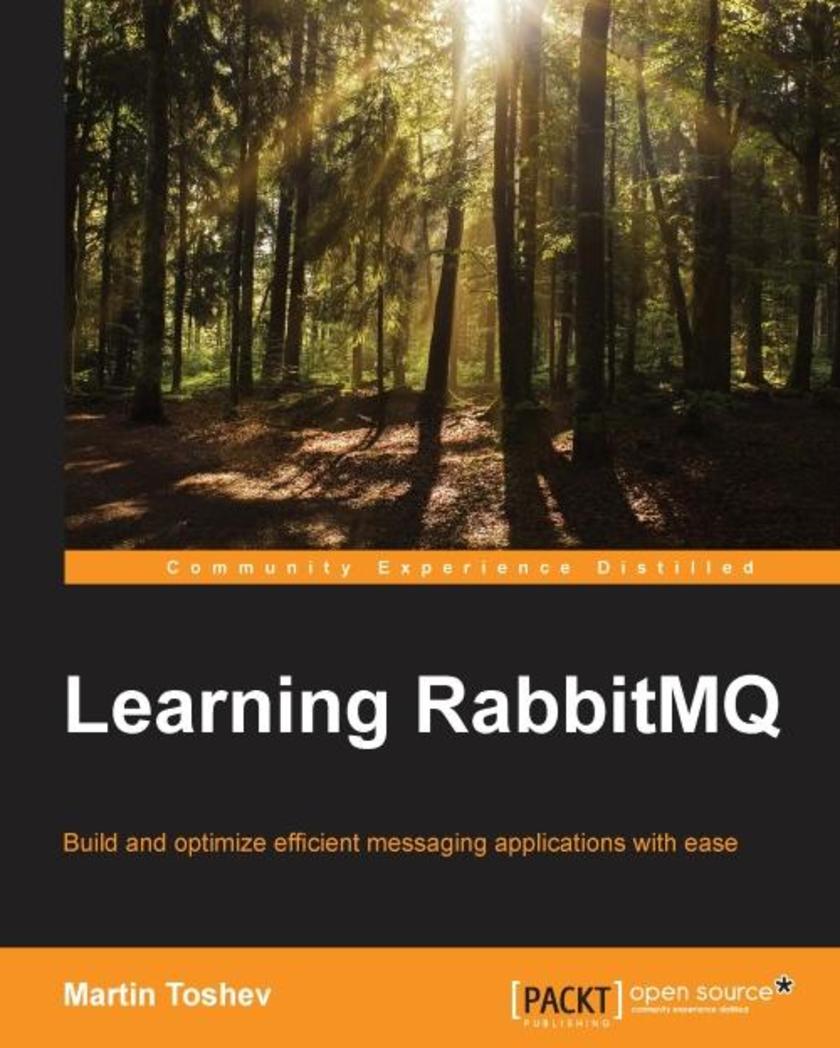
Learning RabbitMQ
¥80.65
Build and optimize efficient messaging applications with ease About This Book Learn to administer, configure, and manage RabbitMQ instances Discover ways to secure and troubleshoot RabbitMQ instances This book is fully up-to-date with all the latest changes to version 3.5 Who This Book Is For If you are a developer or system administrator with a basic knowledge of messaging who wants to learn RabbitMQ, or if you want to further enhance your knowledge in working with the message broker, then this book is ideal for you. To fully understand some examples in the book, a basic knowledge of the Java programming language is required. What You Will Learn Apply messaging patterns using the message broker Administer RabbitMQ using the command line, management Web console, or management REST services Create a cluster of scalable, and highly-available, RabbitMQ instances Use RabbitMQ with the Spring Framework, MuleESB, WSO2, and Oracle databases Deploy RabbitMQ using Puppet, Vagrant, or Docker Fine-tune the performance of RabbitMQ Monitor RabbitMQ using Nagios, Munin, or Monit Secure, troubleshoot, and extend RabbitMQ In Detail RabbitMQ is Open Source Message Queuing software based on the Advanced Message Queue Protocol Standard written in the Erlang Language. RabbitMQ is an ideal candidate for large-scale projects ranging from e-commerce and finance to Big Data and social networking because of its ease of use and high performance. Managing RabbitMQ in such a dynamic environment can be a challenging task that requires a good understanding not only of how to work properly with the message broker but also of its best practices and pitfalls. Learning RabbitMQ starts with a concise de*ion of messaging solutions and patterns, then moves on to concrete practical scenarios for publishing and subscribing to the broker along with basic administration. This knowledge is further expanded by exploring how to establish clustering and high availability at the level of the message broker and how to integrate RabbitMQ with a number of technologies such as Spring, and enterprise service bus solutions such as MuleESB and WSO2. We will look at advanced topics such as performance tuning, secure messaging, and the internals of RabbitMQ. Finally we will work through case-studies so that we can see RabbitMQ in action and, if something goes wrong, we'll learn to resolve it in the Troubleshooting section. Style and approach Each chapter of the book is an easy-to-follow guide that expands and builds on the knowledge already gained in previous chapters. Throughout the course of the book, a sample system called the CSN (Corporate Social Network) is used to illustrate the core principles described. At the end of each chapter, there is a Q&A session that covers practical questions that may arise in practice when working with RabbitMQ.
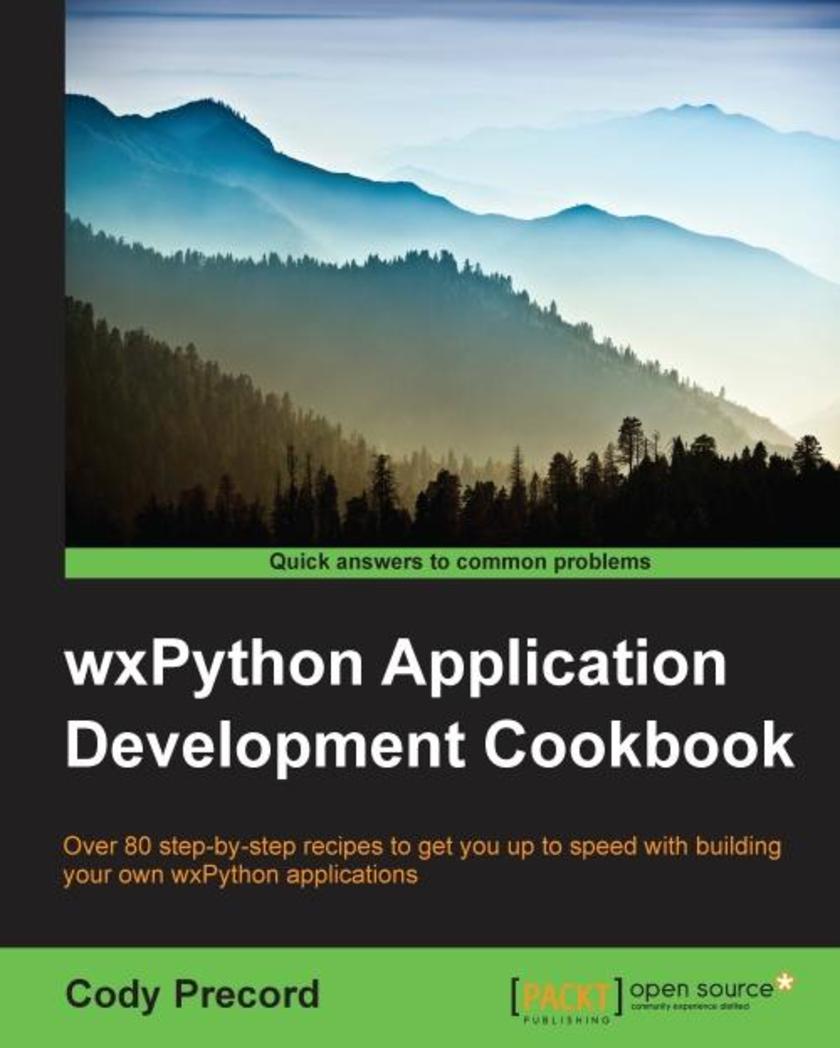
wxPython Application Development Cookbook
¥80.65
Over 80 step-by-step recipes to get you up to speed with building your own wxPython applications About This Book This book empowers you to create rich cross-platform graphical user interfaces using Python It helps you develop applications that can be deployed on Windows, OSX, and Linux The recipes in the book involve real-world applications, giving you a first-hand experience of the practical scenarios Who This Book Is For For those who are familiar with programming in Python and want to start building applications with graphical user interfaces, this book will get you up and running quickly. A basic understanding of the Python programming language and object-oriented concepts are all that is needed. What You Will Learn Create full featured user interfaces Design and develop custom controls Deploy and distribute wxPython applications to Windows, Macintosh OS X, Linux, and other UNIX-like environments Handle and respond to application events Manage and display data using grids Interact with web services from your GUI Use Paint events to draw custom displays Support the display of user interfaces in multiple languages In Detail wxPython is a GUI toolkit for the Python programming language built on top of the cross-platform wxWidgets GUI libraries. wxPython provides a powerful set of tools that allow you to quickly and efficiently building applications that can run on a variety of different platforms. Since wxWidgets provides a wrapper around each platform’s native GUI toolkit, the applications built with wxPython will have a native look and feel wherever they are deployed. This book will provide you with the skills to build highly functional and native looking user interfaces for Python applications on multiple operating system environments. By working through the recipes, you will gain insights into and exposure to creating applications using wxPython. With a wide range of topics covered in the book, there are recipes to get the most basic of beginners started in GUI programming as well as tips to help experienced users get more out of their applications. The recipes will take you from the most basic application constructs all the way through to the deployment of complete applications. Style and approach This book is a collection of step-by-step recipes that introduce the various components and concepts of wxPython in a conversational and easy-to-follow way. Each recipe contains coded examples along with detailed explanations about the key points of each topic. Each topic is designed to introduce and show you how to use a single feature from the wxPython library.
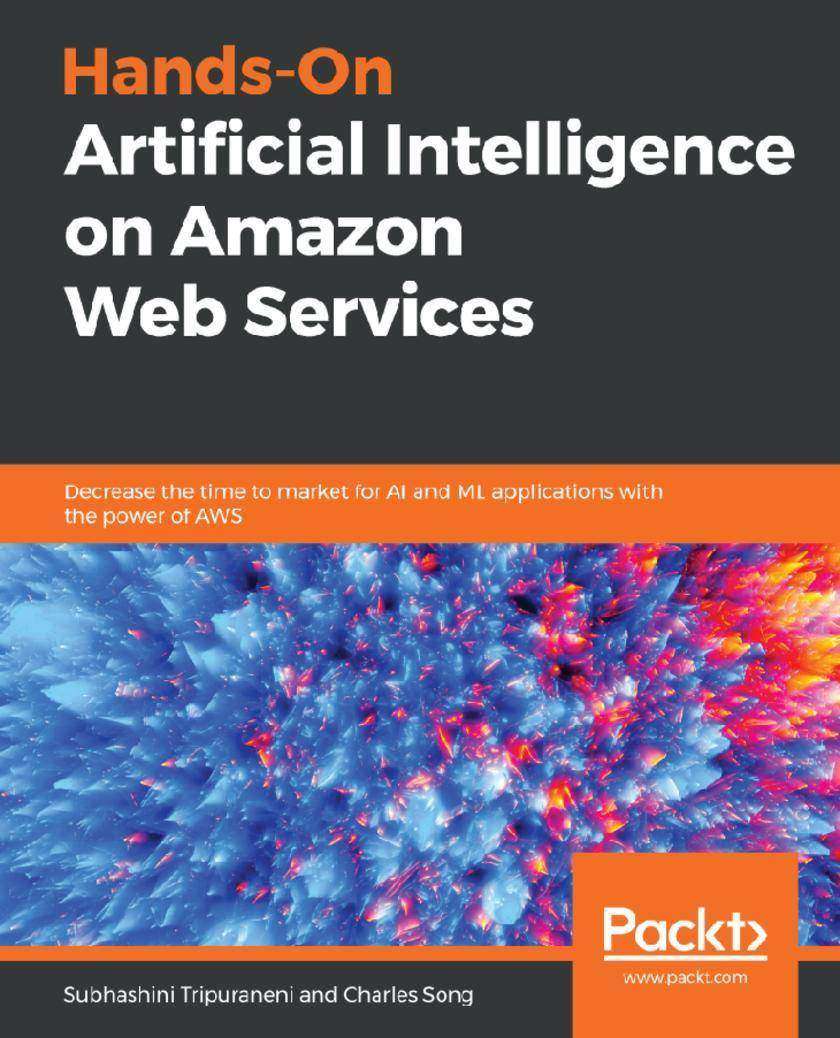
Hands-On Artificial Intelligence on Amazon Web Services
¥80.65
Perform cloud-based machine learning and deep learning using Amazon Web Services such as SageMaker, Lex, Comprehend, Translate, and Polly Key Features * Explore popular machine learning and deep learning services with their underlying algorithms * Discover readily available artificial intelligence(AI) APIs on AWS like Vision and Language Services * Design robust architectures to enable experimentation, extensibility, and maintainability of AI apps Book Description From data wrangling through to translating text, you can accomplish this and more with the artificial intelligence and machine learning services available on AWS. With this book, you’ll work through hands-on exercises and learn to use these services to solve real-world problems. You’ll even design, develop, monitor, and maintain machine and deep learning models on AWS. The book starts with an introduction to AI and its applications in different industries, along with an overview of AWS artificial intelligence and machine learning services. You’ll then get to grips with detecting and translating text with Amazon Rekognition and Amazon Translate. The book will assist you in performing speech-to-text with Amazon Transcribe and Amazon Polly. Later, you’ll discover the use of Amazon Comprehend for extracting information from text, and Amazon Lex for building voice chatbots. You will also understand the key capabilities of Amazon SageMaker such as wrangling big data, discovering topics in text collections, and classifying images. Finally, you’ll cover sales forecasting with deep learning and autoregression, before exploring the importance of a feedback loop in machine learning. By the end of this book, you will have the skills you need to implement AI in AWS through hands-on exercises that cover all aspects of the ML model life cycle. What you will learn * Gain useful insights into different machine and deep learning models * Build and deploy robust deep learning systems to production * Train machine and deep learning models with diverse infrastructure specifications * Scale AI apps without dealing with the complexity of managing the underlying infrastructure * Monitor and Manage AI experiments efficiently * Create AI apps using AWS pre-trained AI services Who this book is for This book is for data scientists, machine learning developers, deep learning researchers, and artificial intelligence enthusiasts who want to harness the power of AWS to implement powerful artificial intelligence solutions. A basic understanding of machine learning concepts is expected.
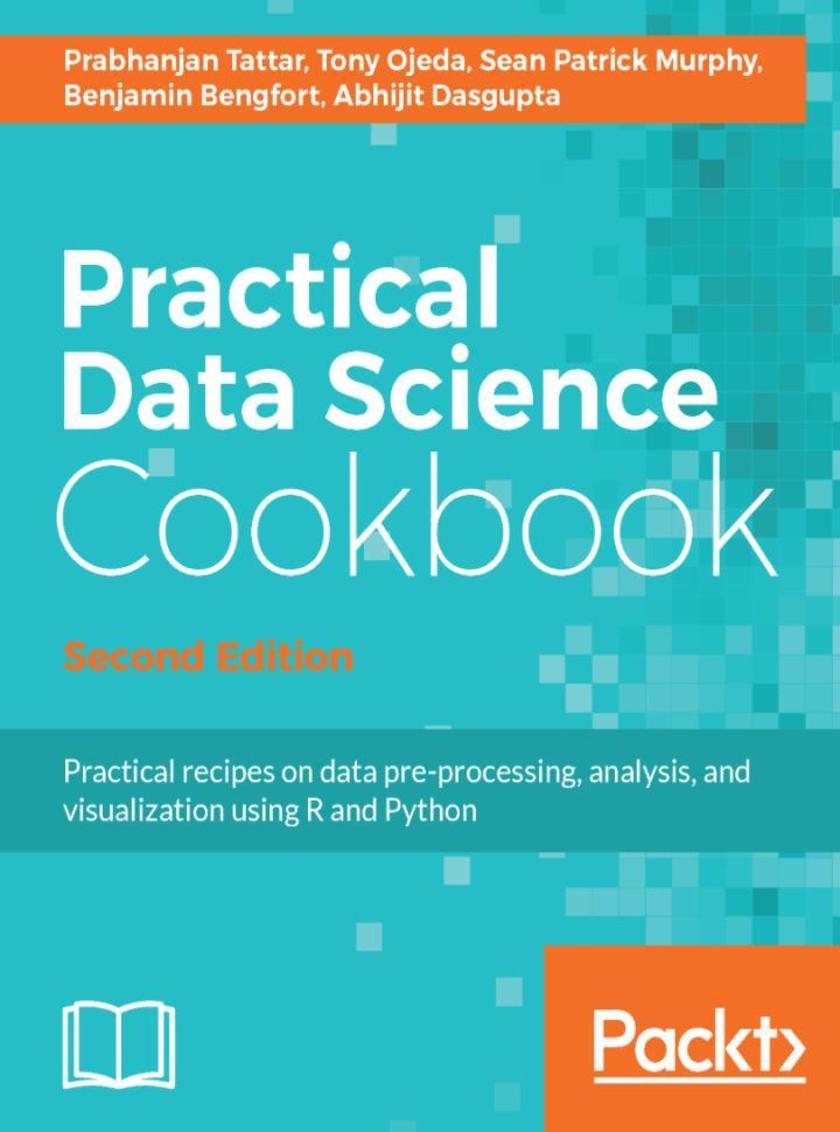
Practical Data Science Cookbook - Second Edition
¥80.65
Over 85 recipes to help you complete real-world data science projects in R and Python About This Book ? Tackle every step in the data science pipeline and use it to acquire, clean, analyze, and visualize your data ? Get beyond the theory and implement real-world projects in data science using R and Python ? Easy-to-follow recipes will help you understand and implement the numerical computing concepts Who This Book Is For If you are an aspiring data scientist who wants to learn data science and numerical programming concepts through hands-on, real-world project examples, this is the book for you. Whether you are brand new to data science or you are a seasoned expert, you will benefit from learning about the structure of real-world data science projects and the programming examples in R and Python. What You Will Learn ? Learn and understand the installation procedure and environment required for R and Python on various platforms ? Prepare data for analysis by implement various data science concepts such as acquisition, cleaning and munging through R and Python ? Build a predictive model and an exploratory model ? Analyze the results of your model and create reports on the acquired data ? Build various tree-based methods and Build random forest In Detail As increasing amounts of data are generated each year, the need to analyze and create value out of it is more important than ever. Companies that know what to do with their data and how to do it well will have a competitive advantage over companies that don’t. Because of this, there will be an increasing demand for people that possess both the analytical and technical abilities to extract valuable insights from data and create valuable solutions that put those insights to use. Starting with the basics, this book covers how to set up your numerical programming environment, introduces you to the data science pipeline, and guides you through several data projects in a step-by-step format. By sequentially working through the steps in each chapter, you will quickly familiarize yourself with the process and learn how to apply it to a variety of situations with examples using the two most popular programming languages for data analysis—R and Python. Style and approach This step-by-step guide to data science is full of hands-on examples of real-world data science tasks. Each recipe focuses on a particular task involved in the data science pipeline, ranging from readying the dataset to analytics and visualization
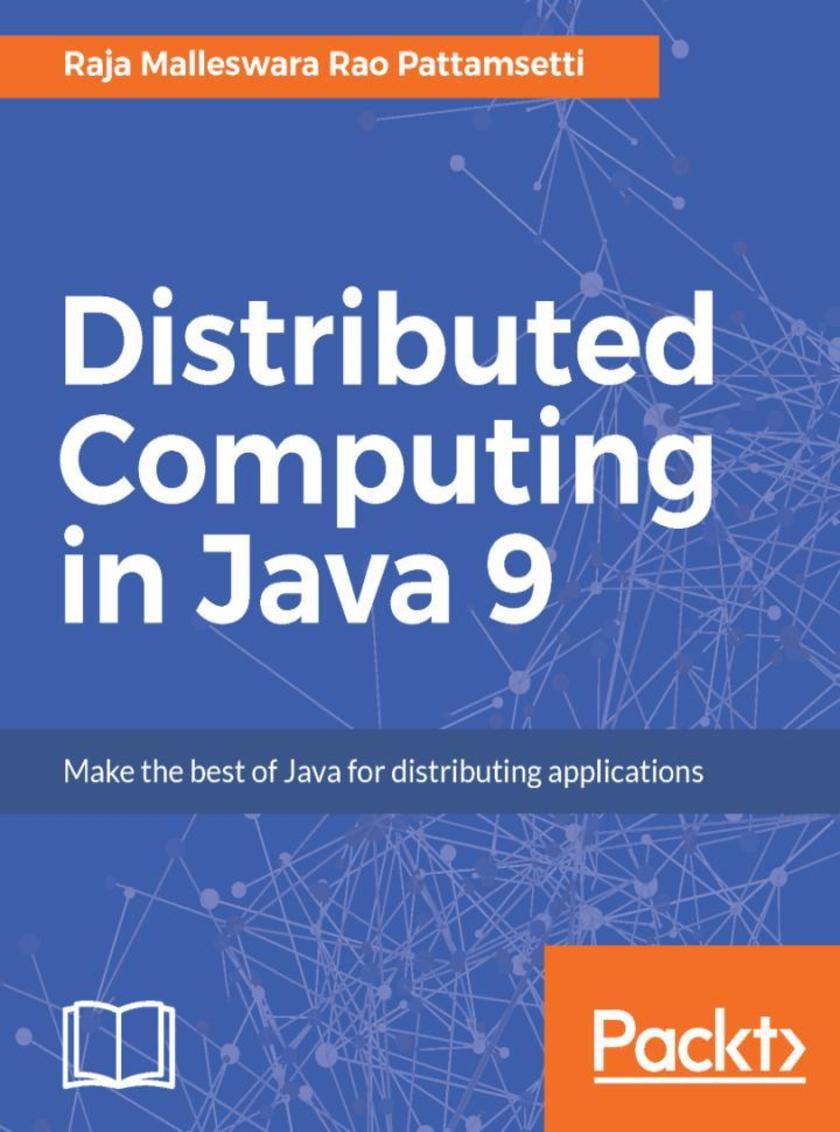
Distributed Computing in Java 9
¥80.65
Explore the power of distributed computing to write concurrent, scalable applications in Java About This Book ? Make the best of Java 9 features to write succinct code ? Handle large amounts of data using HPC ? Make use of AWS and Google App Engine along with Java to establish a powerful remote computation system Who This Book Is For This book is for basic to intermediate level Java developers who is aware of object-oriented programming and Java basic concepts. What You Will Learn ? Understand the basic concepts of parallel and distributed computing/programming ? Achieve performance improvement using parallel processing, multithreading, concurrency, memory sharing, and hpc cluster computing ? Get an in-depth understanding of Enterprise Messaging concepts with Java Messaging Service and Web Services in the context of Enterprise Integration Patterns ? Work with Distributed Database technologies ? Understand how to develop and deploy a distributed application on different cloud platforms including Amazon Web Service and Docker CaaS Concepts ? Explore big data technologies ? Effectively test and debug distributed systems ? Gain thorough knowledge of security standards for distributed applications including two-way Secure Socket Layer In Detail Distributed computing is the concept with which a bigger computation process is accomplished by splitting it into multiple smaller logical activities and performed by diverse systems, resulting in maximized performance in lower infrastructure investment. This book will teach you how to improve the performance of traditional applications through the usage of parallelism and optimized resource utilization in Java 9. After a brief introduction to the fundamentals of distributed and parallel computing, the book moves on to explain different ways of communicating with remote systems/objects in a distributed architecture. You will learn about asynchronous messaging with enterprise integration and related patterns, and how to handle large amount of data using HPC and implement distributed computing for databases. Moving on, it explains how to deploy distributed applications on different cloud platforms and self-contained application development. You will also learn about big data technologies and understand how they contribute to distributed computing. The book concludes with the detailed coverage of testing, debugging, troubleshooting, and security aspects of distributed applications so the programs you build are robust, efficient, and secure. Style and approach This is a step-by-step practical guide with real-world examples.
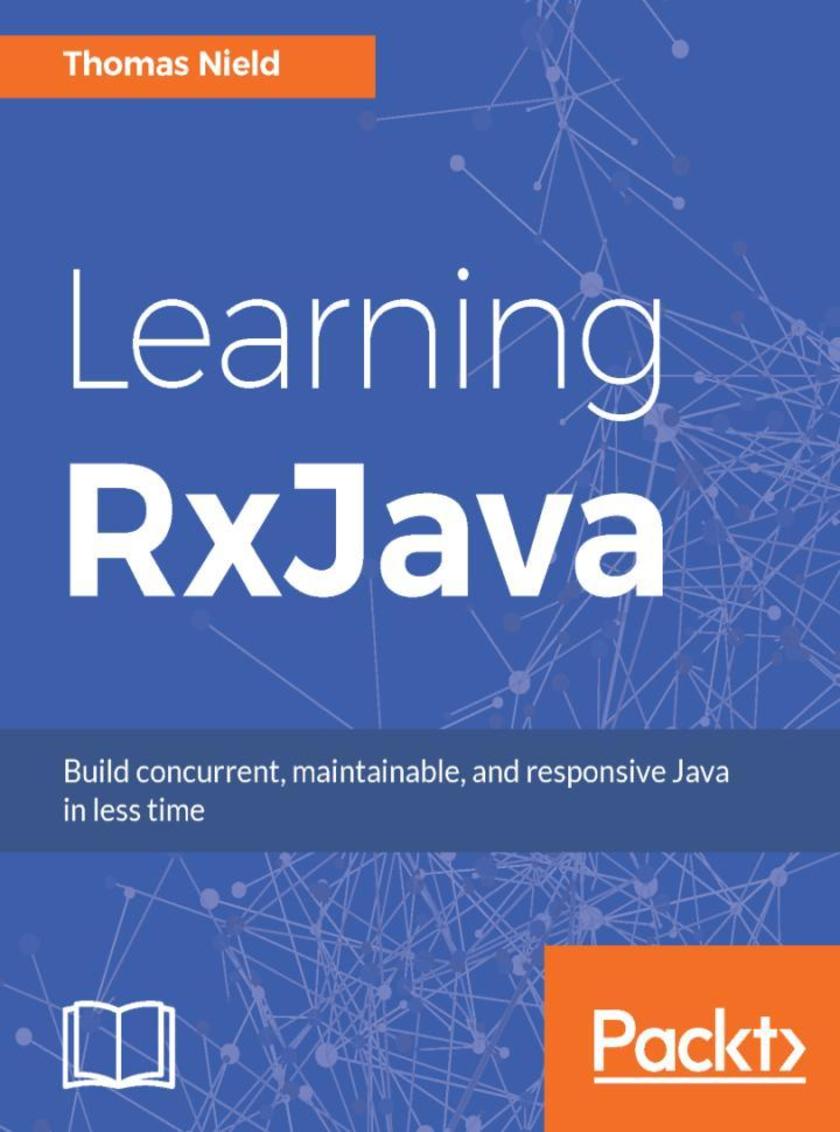
Learning RxJava
¥80.65
Reactive Programming with Java and ReactiveX About This Book ? Explore the essential tools and operators RxJava provides, and know which situations to use them in ? Delve into Observables and Subscribers, the core components of RxJava used for building scalable and performant reactive applications ? Delve into the practical implementation of tools to effectively take on complex tasks such as concurrency and backpressure Who This Book Is For The primary audience for this book is developers with at least a fundamental mastery of Java. Some readers will likely be interested in RxJava to make programs more resilient, concurrent, and scalable. Others may be checking out reactive programming just to see what it is all about, and to judge whether it can solve any problems they may have. What You Will Learn ? Learn the features of RxJava 2 that bring about many significant changes, including new reactive types such as Flowable, Single, Maybe, and Completable ? Understand how reactive programming works and the mindset to "think reactively" ? Demystify the Observable and how it quickly expresses data and events as sequences ? Learn the various Rx operators that transform, filter, and combine data and event sequences ? Leverage multicasting to push data to multiple destinations, and cache and replay them ? Discover how concurrency and parallelization work in RxJava, and how it makes these traditionally complex tasks trivial to implement ? Apply RxJava and Retrolambda to the Android domain to create responsive Android apps with better user experiences ? Use RxJava with the Kotlin language to express RxJava more idiomatically with extension functions, data classes, and other Kotlin features In Detail RxJava is a library for composing asynchronous and event-based programs using Observable sequences for the JVM, allowing developers to build robust applications in less time. Learning RxJava addresses all the fundamentals of reactive programming to help readers write reactive code, as well as teach them an effective approach to designing and implementing reactive libraries and applications. Starting with a brief introduction to reactive programming concepts, there is an overview of Observables and Observers, the core components of RxJava, and how to combine different streams of data and events together. You will also learn simpler ways to achieve concurrency and remain highly performant, with no need for synchronization. Later on, we will leverage backpressure and other strategies to cope with rapidly-producing sources to prevent bottlenecks in your application. After covering custom operators, testing, and debugging, the book dives into hands-on examples using RxJava on Android as well as Kotlin. Style and approach This book will be different from other Rx books, taking an approach that comprehensively covers Rx concepts and practical applications.
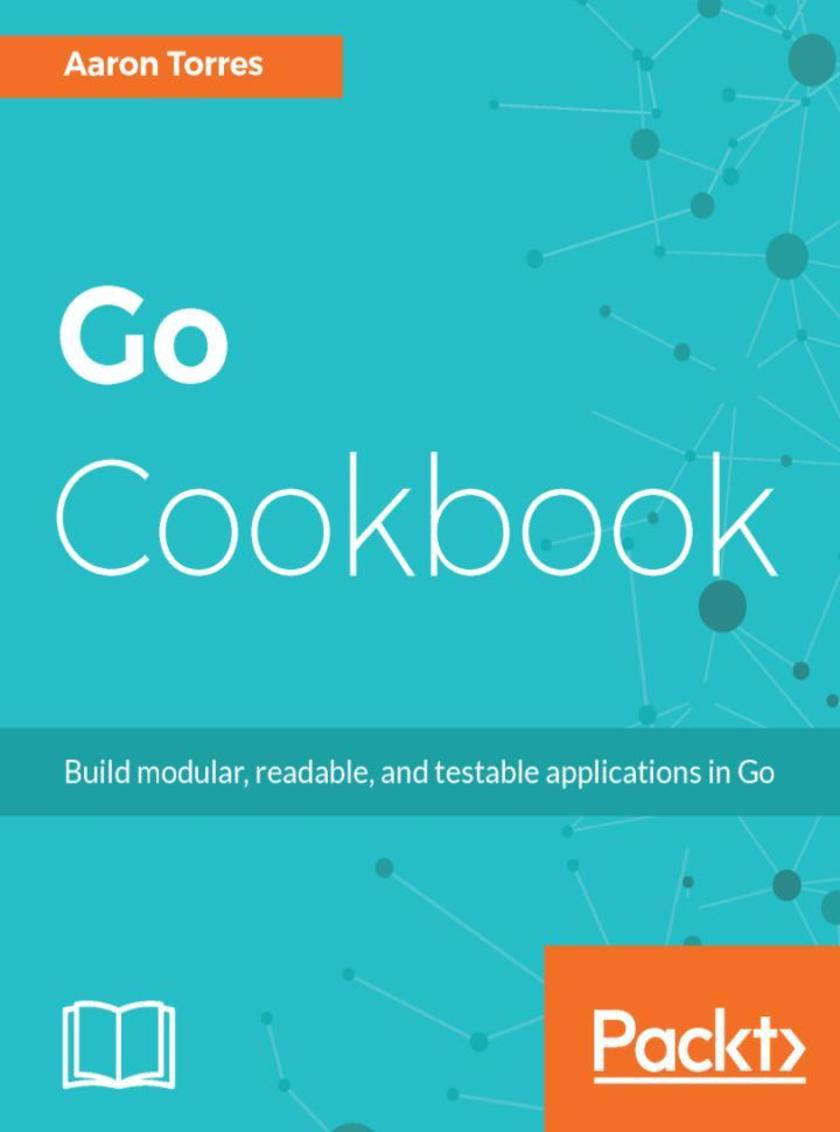
Go Cookbook
¥80.65
Bridge the gap between basic understanding of Go and use of its advanced features About This Book ? Discover a number of recipes and approaches to develop modern back-end applications ? Put to use the best practices to combine the recipes for sophisticated parallel tools ? This book is based on Go 1.8, which is the latest version Who This Book Is For This book is for web developers, programmers, and enterprise developers. Basic knowledge of the Go language is assumed. Experience with back-end application development is not necessary, but may help understand the motivation behind some of the recipes. What You Will Learn ? Test your application using advanced testing methodologies ? Develop an awareness of application structures, interface design, and tooling ? Create strategies for third-party packages, dependencies, and vendoring ? Get to know tricks on treating data such as collections ? Handle errors and cleanly pass them along to calling functions ? Wrap dependencies in interfaces for ease of portability and testing ? Explore reactive programming design patterns in Go In Detail Go (a.k.a. Golang) is a statically-typed programming language first developed at Google. It is derived from C with additional features such as garbage collection, type safety, dynamic-typing capabilities, additional built-in types, and a large standard library. This book takes off where basic tutorials on the language leave off. You can immediately put into practice some of the more advanced concepts and libraries offered by the language while avoiding some of the common mistakes for new Go developers. The book covers basic type and error handling. It explores applications that interact with users, such as websites, command-line tools, or via the file system. It demonstrates how to handle advanced topics such as parallelism, distributed systems, and performance tuning. Lastly, it finishes with reactive and serverless programming in Go. Style and approach This guide is a handy reference for developers to quickly look up Go development patterns. It is a companion to other resources and a reference that will be useful long after reading it through the first time. Each recipe includes working, simple, and tested code that can be used as a reference or foundation for your own applications.
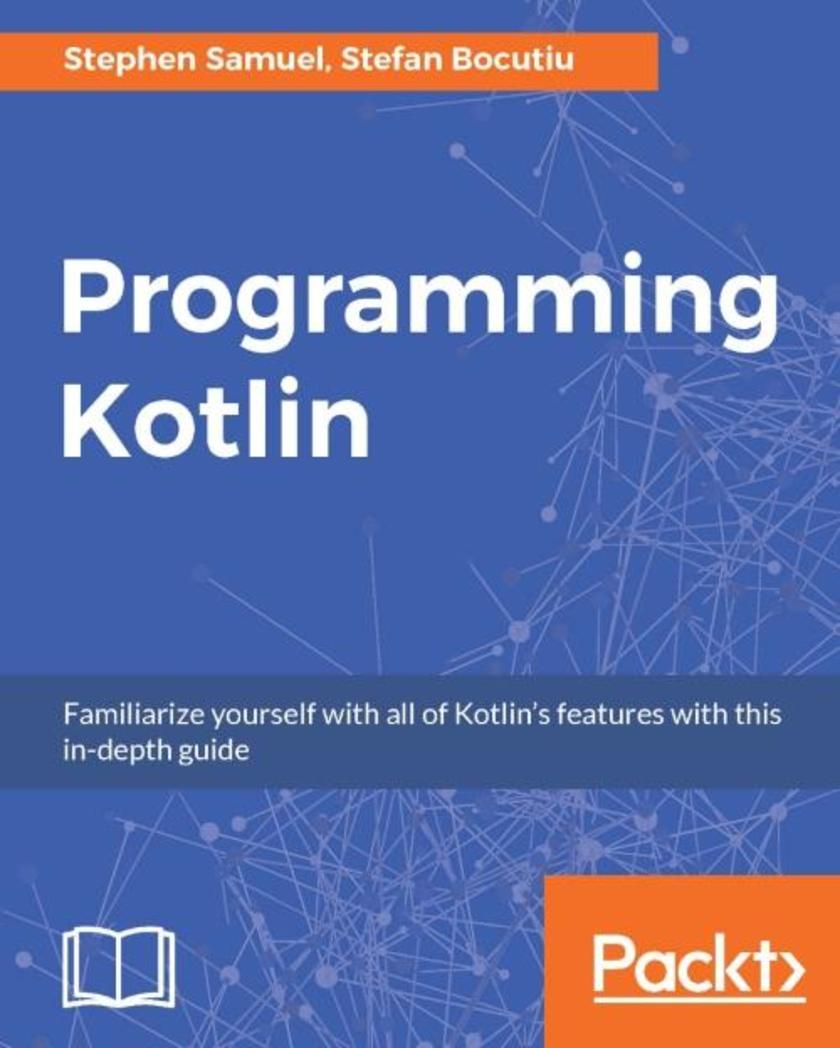
Programming Kotlin
¥80.65
Familiarize yourself with all of Kotlin’s features with this in-depth guide About This Book Get a thorough introduction to Kotlin Learn to use Java code alongside Kotlin without any hiccups Get a complete overview of null safety, Generics, and many more interesting features Who This Book Is For The book is for existing Java developers who want to learn more about an alternative JVM language. If you want to see what Kotlin has to offer, this book is ideal for you. What You Will Learn Use new features to write structured and readable object-oriented code Find out how to use lambdas and higher order functions to write clean, reusable, and simple code Write unit tests and integrate Kotlin tests with Java code in a transitioning code base Write real-world production code in Kotlin in the style of microservices Leverage Kotlin’s extensions to the Java collections library Use destructuring expressions and find out how to write your own Write code that avoids null pointer errors and see how Java-nullable code can integrate with features in a Kotlin codebase Discover how to write functions in Kotlin, see the new features available, and extend existing libraries Learn to write an algebraic data types and figure out when they should be used In Detail Kotlin has been making waves ever since it was open sourced by JetBrains in 2011; it has been praised by developers across the world and is already being adopted by companies. This book provides a detailed introduction to Kotlin that shows you all its features and will enable you to write Kotlin code to production. We start with the basics: get you familiar with running Kotlin code, setting up, tools, and instructions that you can use to write basic programs. Next, we cover object oriented code: functions, lambdas, and properties – all while using Kotlin’s new features. Then, we move on to null safety aspects and type parameterization. We show you how to destructure expressions and even write your own. We also take you through important topics like testing, concurrency, microservices, and a whole lot more. By the end of this book you will be able to compose different services and build your own applications. Style and approach An easy to follow guide that covers the full set of features in Kotlin programming.
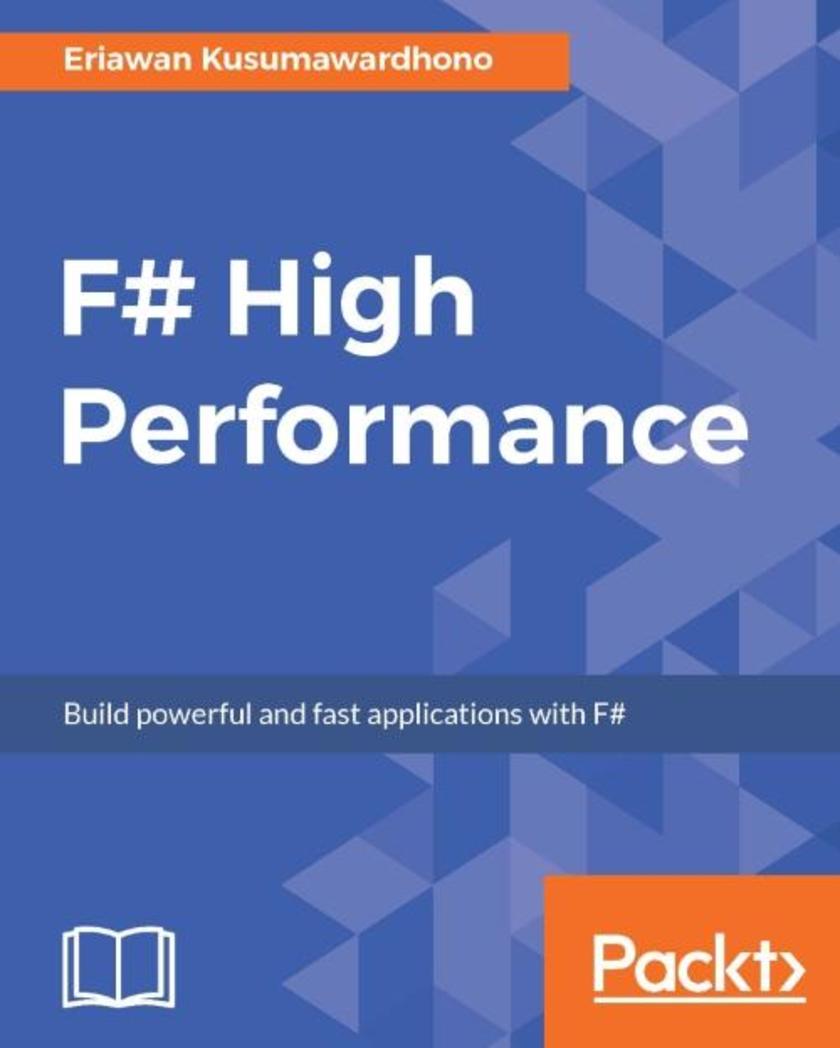
F# High Performance
¥80.65
Build powerful and fast applications with F# About This Book· Explore the advanced concurrency support in F# and .NET TPL·Covers major optimization techniques in F# to improve the performance of applications·Use Struct, Class and Record model, Interop with C# and VB without sacrificing performance. Who This Book Is For This book is for F# developers who want to build high-performance applications. Knowledge of functional programming would be helpful. What You Will Learn· Understand how the execution of functions in F# works·Identify common performance bottlenecks·Implement best practices to optimize performance·Use the available tooling to help measure performance·Combine the best practice of asynchronous and synchronous·Optimize further using various F# language constructs In Detail F# is a functional programming language and is used in enterprise applications that demand high performance. It has its own unique trait: it is a functional programming language and has OOP support at the same time. This book will help you make F# applications run faster with examples you can easily break down and take into your own work. You will be able to assess the performance of the program and identify bottlenecks. Beginning with a gentle overview of concurrency features in F#, you will get to know the advanced topics of concurrency optimizations in F#, such as F# message passing agent of MailboxProcessor and further interoperation with .NET TPL. Based on this knowledge, you will be able to enhance the performance optimizations when implementing and using other F# language features. The book also covers optimization techniques by using F# best practices and F# libraries. You will learn how the concepts of concurrency and parallel programming will help in improving the performance. With this, you would be able to take advantage of multi-core processors and track memory leaks, root causes, and CPU issues. Finally, you will be able to test their applications to achieve scalability. Style and approach This easy-to-follow guide is full of hands-on examples of real-world multithreading tasks. Each topic is explained and placed in context, and for the more inquisitive, there are also more in-depth details of the concepts used.
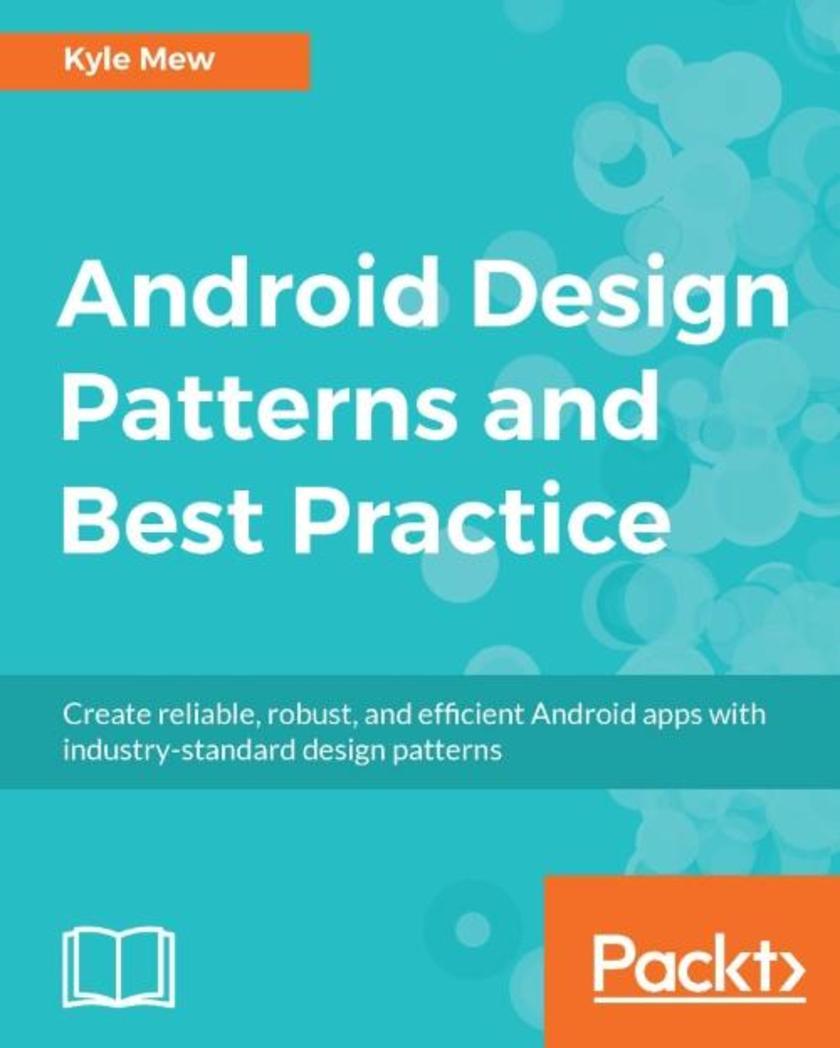
Android Design Patterns and Best Practice
¥80.65
Create reliable, robust, and efficient Android apps with industry-standard design patterns About This Book Create efficient object interaction patterns for faster and more efficient Android development Get into efficient and fast app development and start making money from your android apps Implement industry-standard design patterns and best practices to reduce your app development time drastically Who This Book Is For This book is intended for Android developers who have some basic android development experience. Basic Java programming knowledge is a must to get the most out of this book. What You Will Learn Build a simple app and run it on real and emulated devices Explore the WYSIWYG and XML approaches to material design provided within Android Studio Detect user activities by using touch screen listeners, gesture detection, and reading sensors Apply transitions and shared elements to employ elegant animations and efficiently use the minimal screen space of mobile devices Develop apps that automatically apply the best layouts for different devices by using designated directories Socialize in the digital word by connecting your app to social media Make your apps available to the largest possible audience with the AppCompat support library In Detail Are you an Android developer with some experience under your beltAre you wondering how the experts create efficient and good-looking appsThen your wait will end with this book! We will teach you about different Android development patterns that will enable you to write clean code and make your app stand out from the crowd. The book starts by introducing the Android development environment and exploring the support libraries. You will gradually explore the different design and layout patterns and get to know the best practices of how to use them together. Then you’ll then develop an application that will help you grasp activities, services, and broadcasts and their roles in Android development. Moving on, you will add user-detecting classes and APIs such as gesture detection, touch screen listeners, and sensors to your app. You will also learn to adapt your app to run on tablets and other devices and platforms, including Android Wear, auto, and TV. Finally, you will see how to connect your app to social media and explore deployment patterns as well as the best publishing and monetizing practices. The book will start by introducing the Android development environment and exploring the support libraries. You will gradually explore the different Design and layout patterns and learn the best practices on how to use them together. You will then develop an application that will help you grasp Activities, Services and Broadcasts and their roles in Android development. Moving on, you will add user detecting classes and APIs such as at gesture detection, touch screen listeners and sensors to our app. You will also learn to adapt your app to run on tablets and other devices and platforms, including Android Wear, Auto, and TV. Finally, you will learn to connect your app to social media and explore deployment patterns and best publishing and monetizing practices. Style and approach This book takes a step-by-step approach. The steps are explained using real-world practical examples. Each chapter uses case studies where we show you how using design patterns will help in your development process.
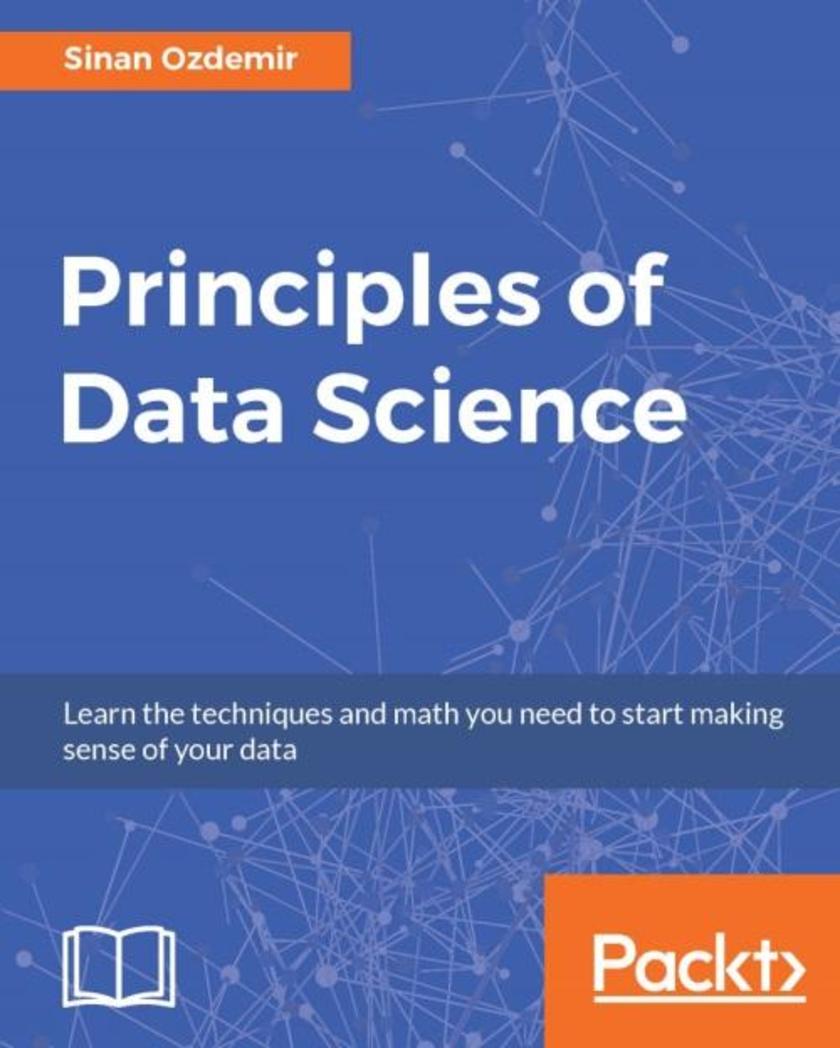
Principles of Data Science
¥80.65
Learn the techniques and math you need to start making sense of your data About This Book Enhance your knowledge of coding with data science theory for practical insight into data science and analysis More than just a math class, learn how to perform real-world data science tasks with R and Python Create actionable insights and transform raw data into tangible value Who This Book Is For You should be fairly well acquainted with basic algebra and should feel comfortable reading snippets of R/Python as well as pseudo code. You should have the urge to learn and apply the techniques put forth in this book on either your own data sets or those provided to you. If you have the basic math skills but want to apply them in data science or you have good programming skills but lack math, then this book is for you. What You Will Learn Get to know the five most important steps of data science Use your data intelligently and learn how to handle it with care Bridge the gap between mathematics and programming Learn about probability, calculus, and how to use statistical models to control and clean your data and drive actionable results Build and evaluate baseline machine learning models Explore the most effective metrics to determine the success of your machine learning models Create data visualizations that communicate actionable insights Read and apply machine learning concepts to your problems and make actual predictions In Detail Need to turn your skills at programming into effective data science skillsPrinciples of Data Science is created to help you join the dots between mathematics, programming, and business analysis. With this book, you’ll feel confident about asking—and answering—complex and sophisticated questions of your data to move from abstract and raw statistics to actionable ideas. With a unique approach that bridges the gap between mathematics and computer science, this books takes you through the entire data science pipeline. Beginning with cleaning and preparing data, and effective data mining strategies and techniques, you’ll move on to build a comprehensive picture of how every piece of the data science puzzle fits together. Learn the fundamentals of computational mathematics and statistics, as well as some pseudocode being used today by data scientists and analysts. You’ll get to grips with machine learning, discover the statistical models that help you take control and navigate even the densest datasets, and find out how to create powerful visualizations that communicate what your data means. Style and approach This is an easy-to-understand and accessible tutorial. It is a step-by-step guide with use cases, examples, and illustrations to get you well-versed with the concepts of data science. Along with explaining the fundamentals, the book will also introduce you to slightly advanced concepts later on and will help you implement these techniques in the real world.
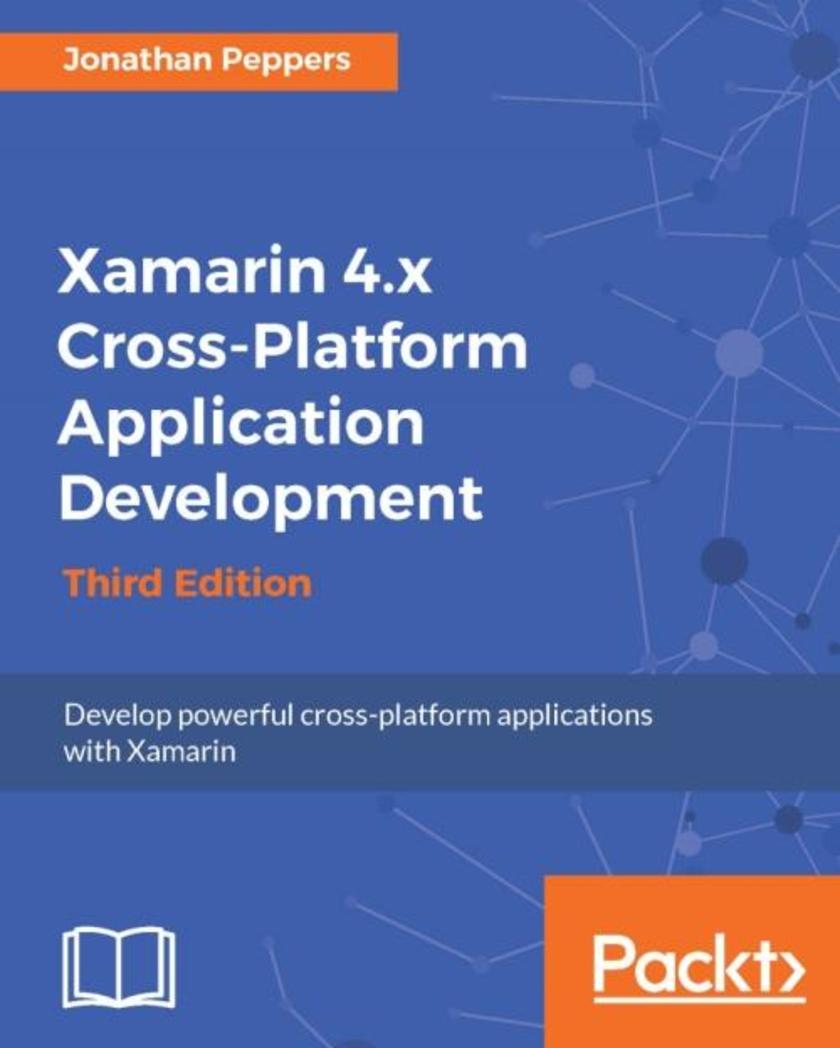
Xamarin 4.x Cross-Platform Application Development - Third Edition
¥80.65
Develop powerful cross-platform applications with Xamarin About This Book Write native cross-platform applications with Xamarin Design user interfaces that can be shared across Android, iOS, and Windows Phone using Xamarin.Forms Practical cross-platform development strategies Who This Book Is For If you are a developer with experience in C# and are just getting into mobile development, this is the book for you. This book will give you a head start with cross-platform development and will be the most useful to developers who have experience with desktop applications or the web. What You Will Learn Apple’s MVC design pattern The Android activity lifecycle Share C# code across platforms and call native Objective-C or Java libraries from C# Create a real web service back end in Windows Azure using SQL Azure as database storage Set up third-party libraries such as NuGet and Objective Sharpie in many different ways, and port a desktop .NET library to Xamarin Use Xamarin.Mobile for camera, contacts, and location In Detail Xamarin is a leading cross-platform application development tool used by top companies such as Coca-Cola, Honeywell, and Alaska Airlines to build apps. Version 4 features significant updates to the platform including the release of Xamarin.Forms 2.0 and improvements have been made to the iOS and Android designers. Xamarin was acquired by Microsoft so it is now a part of the Visual Studio family. This book will show you how to build applications for iOS, Android, and Windows. You will be walked through the process of creating an application that comes complete with a back-end web service and native features such as GPS location, camera, push notifications, and other core features. Additionally, you’ll learn how to use external libraries with Xamarin and Xamarin.Forms to create user interfaces. This book also provides instructions for Visual Studio and Windows. This edition has been updated with new screenshots and detailed steps to provide you with a holistic overview of the new features in Xamarin 4. Style and approach This book offers a tutorial style approach to teach you the skills required to develop end-to-end cross-platform solutions with Xamarin.
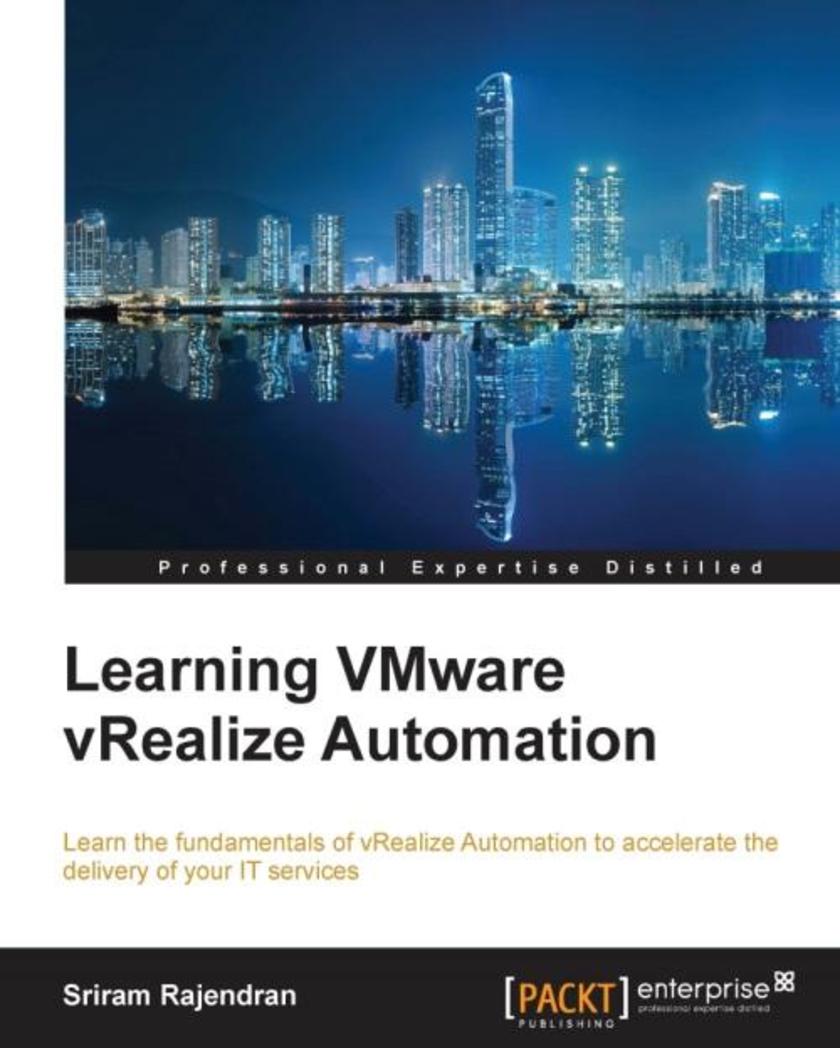
Learning VMware vRealize Automation
¥80.65
Learn the fundamentals of vRealize Automation to accelerate the delivery of your IT servicesAbout This BookLearn to install the vRealize Automation product in a distributed architecture using a load balancerPlan backup and recovery strategies for every vRealize automation componentUse vRealize Automation to manage applications and improve operational efficiency using this simple and intuitive guideWho This Book Is ForThis book is for anyone who wants to start their journey with vRealize Automation. It is your one-stop instruction guide to installing and configuring a distributed setup using NSX load balancer. Regardless of whether or not you have used vRealize Automation before, following the steps provided in each chapter will get you started with the product.What You Will LearnUnderstand the basic building blocks of vRealize Automation before embarking on the journey of installationFamiliarize yourself with the requirements and steps that need to be performed during the first phase of the distributed installationCarry out a functional validation of the first phase of installation before completing the installationBuild a blueprint for vSphere endpoint, an essential step for a successful deployment of a service catalogCreate, configure, and deploy tenants, endpoints, blueprints, and the service catalogGet to grips with the failover process for all components in vRealize AutomationLearn to configure the NSX loadbalancer for vRealize Orchestrator for high availabilityLeverage ASD to develop XaaS (Anything as a Service) in vRealize Automation to deliver valuable competenceIn DetailWith the growing interest in Software Defined Data Centers (SDDC), vRealize Automation offers data center users an organized service catalog and governance for administrators. This way, end users gain autonomy while the IT department stays in control, making sure security and compliance requirements are met. Learning what each component does and how they dovetail with each other will bolster your understanding of vRealize Automation.The book starts off with an introduction to the distributed architecture that has been tested and installed in large scale deployments. Implementing and configuring distributed architecture with custom certificates is unarguably a demanding task, and it will be covered next. After this, we will progress with the installation. A vRealize Automation blueprint can be prepared in multiple ways; we will focus solely on vSphere endpoint blueprint. After this, we will discuss the high availability configuration via NSX loadbalancer for vRealize Orchestrator. Finally, we end with Advanced Service Designer, which provides service architects with the ability to create advanced services and publish them as catalog items.Style and approachThis book takes a step-by-step approach, is explained in a conversational and easy-to-follow style, and includes ample screenshots . Each topic is explained sequentially through planning, preparing, installing, configuring, and validating of all vRealize Automation’s components.
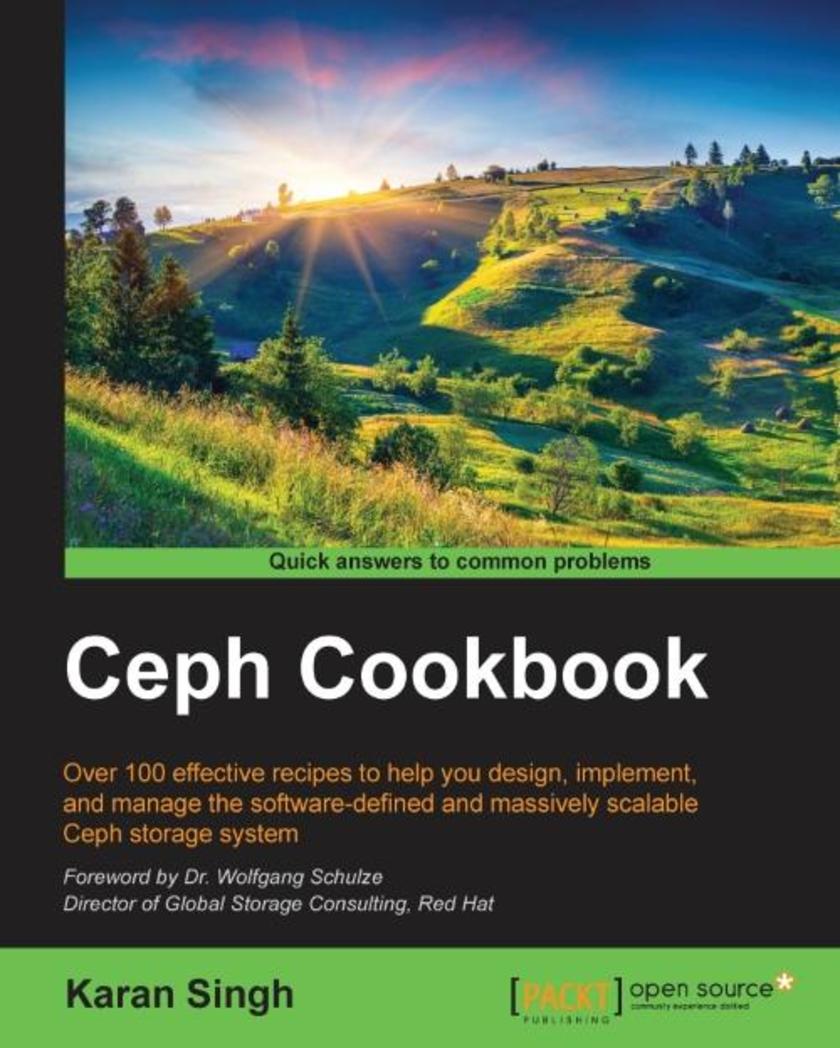
Ceph Cookbook
¥80.65
Over 100 effective recipes to help you design, implement, and manage the software-defined and massively scalable Ceph storage systemAbout This BookImplement a Ceph cluster successfully and gain deep insights into its best practicesHarness the abilities of experienced storage administrators and architects, and run your own software-defined storage systemThis comprehensive, step-by-step guide will show you how to build and manage Ceph storage in production environmentWho This Book Is ForThis book is aimed at storage and cloud system engineers, system administrators, and technical architects who are interested in building software-defined storage solutions to power their cloud and virtual infrastructure. If you have basic knowledge of GNU/Linux and storage systems, with no experience of software defined storage solutions and Ceph, but eager to learn this book is for you.What You Will LearnUnderstand, install, configure, and manage the Ceph storage systemGet to grips with performance tuning and benchmarking, and gain practical tips to run Ceph in productionIntegrate Ceph with OpenStack Cinder, Glance, and nova componentsDeep dive into Ceph object storage, including s3, swift, and keystone integrationBuild a Dropbox-like file sync and share service and Ceph federated gateway setupGain hands-on experience with Calamari and VSM for cluster monitoringFamiliarize yourself with Ceph operations such as maintenance, monitoring, and troubleshootingUnderstand advanced topics including erasure coding, CRUSH map, cache pool, and system maintenanceIn DetailCeph is a unified, distributed storage system designed for excellent performance, reliability, and scalability. This cutting-edge technology has been transforming the storage industry, and is evolving rapidly as a leader in software-defined storage space, extending full support to cloud platforms such as Openstack and Cloudstack, including virtualization platforms. It is the most popular storage backend for Openstack, public, and private clouds, so is the first choice for a storage solution. Ceph is backed by RedHat and is developed by a thriving open source community of individual developers as well as several companies across the globe.This book takes you from a basic knowledge of Ceph to an expert understanding of the most advanced features, walking you through building up a production-grade Ceph storage cluster and helping you develop all the skills you need to plan, deploy, and effectively manage your Ceph cluster. Beginning with the basics, you’ll create a Ceph cluster, followed by block, object, and file storage provisioning. Next, you’ll get a step-by-step tutorial on integrating it with OpenStack and building a Dropbox-like object storage solution. We’ll also take a look at federated architecture and CephFS, and you’ll dive into Calamari and VSM for monitoring the Ceph environment. You’ll develop expert knowledge on troubleshooting and benchmarking your Ceph storage cluster. Finally, you’ll get to grips with the best practices to operate Ceph in a production environment.Style and approach This step-by-step guide is filled with practical tutorials, making complex scenarios easy to understand.
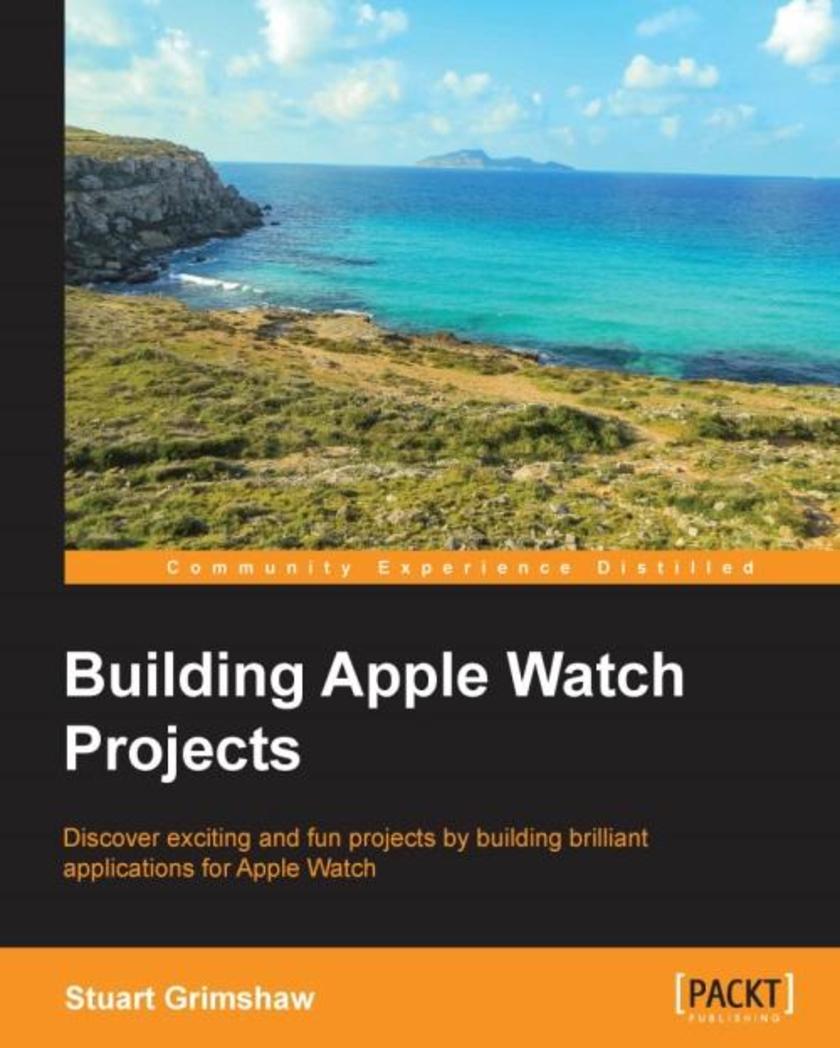
Building Apple Watch Projects
¥80.65
Discover exciting and fun projects by building brilliant applications for the Apple WatchAbout This BookExplore the opportunities opened up to developers by Apple’s latest device: the Apple WatchBe a crackerjack at developing software across a broad range of watch app categoriesFrom an eminent author, master all stages of development, from the first stage through to a completed projectWho This Book Is ForIf you have some basic knowledge of programming in Swift and are looking for the best way to get started with Apple Watch development, this book is just the right one for you!What You Will LearnUnderstand the concept of the Apple Watch as an autonomous device as well as it being paired with the iPhoneGet your app up and runningDesign exciting, inspiring, and attractive layouts for your appsMake your user interface more engaging using images and animationEnable your Watch and iPhone apps to transport and share dataLeverage the feature-rich set of WatchKit technologies provided by AppleConnect your apps to the InternetSubmit your app to the App StoreIn DetailWith Apple’s eagerly anticipated entry into the wearable arena, the field is wide open for a new era of app development. The Apple Watch is one of the most important technologies of our time.This easy-to-understand book takes beginners on a delightful journey of discovering the features available to the developer, right up to the completion of medium-level projects ready for App Store submission. It provides the fastest way to develop real-world apps for the Apple Watch by teaching you the concepts of Watch UI, visual haptic and audio, message and data exchange between watch and phone, Web communication, and finally Visual, haptic as well as audio feedback for users.By the end of this book, you will have developed at least four fully functioning apps for deployment on watchOS 2.Style and approachThis is a step-by-step guide to developing apps for the Apple Watch with the help of screenshots and fully coded working examples.
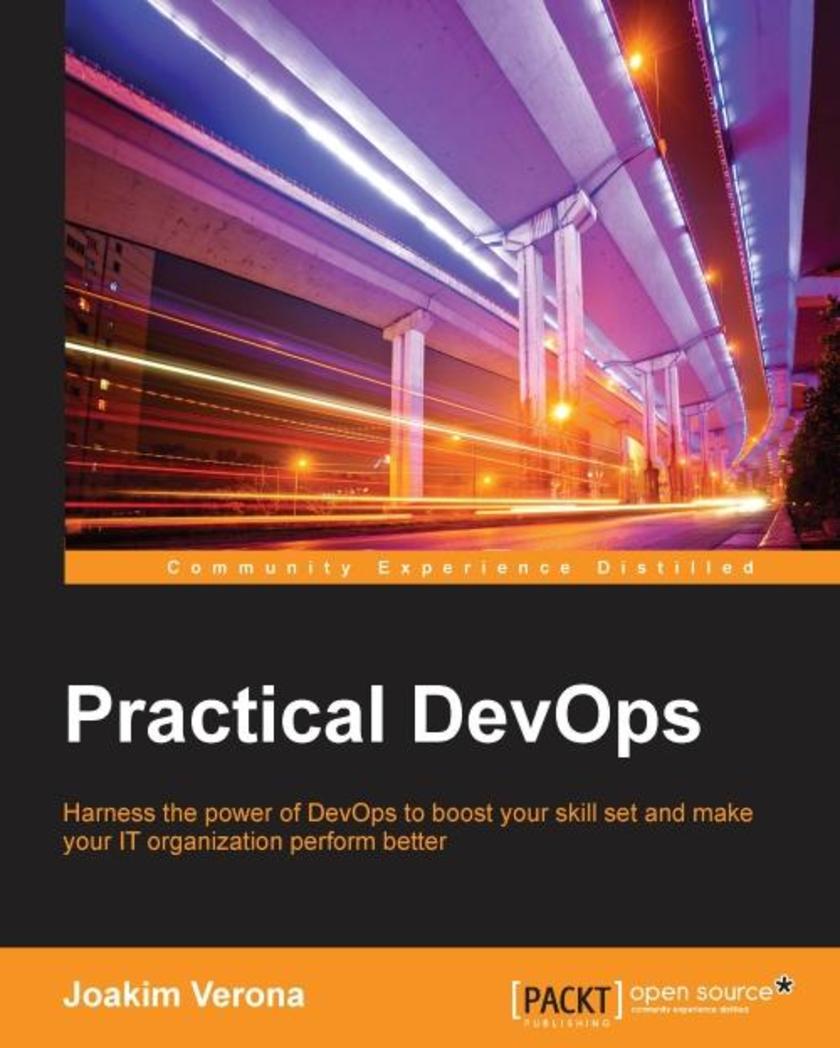
Practical DevOps
¥80.65
Harness the power of DevOps to boost your skill set and make your IT organization perform betterAbout This BookGet to know the background of DevOps so you understand the collaboration between different aspects of an IT organization and a software developerImprove your organization's performance to ensure smooth production of software and servicesDeploy top-quality software and ensure software maintenance and release management with this practical guideWho This Book Is ForThis book is aimed at developers and system administrators who wish to take on larger responsibilities and understand how the infrastructure that builds today's enterprises works. This book is also great for operations personnel who would like to better support developers. You do not need to have any previous knowledge of DevOps.What You Will LearnAppreciate the merits of DevOps and continuous delivery and see how DevOps supports the agile processUnderstand how all the systems fit together to form a larger wholeSet up and familiarize yourself with all the tools you need to be efficient with DevOpsDesign an application that is suitable for continuous deployment systems with Devops in mindStore and manage your code effectively using different options such as Git, Gerrit, and GitlabConfigure a job to build a sample CRUD applicationTest the code using automated regression testing with Jenkins SeleniumDeploy your code using tools such as Puppet, Ansible, Palletops, Chef, and VagrantMonitor the health of your code with Nagios, Munin, and GraphiteExplore the workings of Trac—a tool used for issue trackingIn DetailDevOps is a practical field that focuses on delivering business value as efficiently as possible. DevOps encompasses all the flows from code through testing environments to production environments. It stresses the cooperation between different roles, and how they can work together more closely, as the roots of the word imply—Development and Operations.After a quick refresher to DevOps and continuous delivery, we quickly move on to looking at how DevOps affects architecture. You'll create a sample enterprise Java application that you’ll continue to work with through the remaining chapters. Following this, we explore various code storage and build server options. You will then learn how to perform code testing with a few tools and deploy your test successfully. Next, you will learn how to monitor code for any anomalies and make sure it’s running properly. Finally, you will discover how to handle logs and keep track of the issues that affect processesStyle and approachThis book is primarily a technical guide to DevOps with practical examples suitable for people who like to learn by implementing concrete working code. It starts out with background information and gradually delves deeper into technical subjects.




 购物车
购物车 个人中心
个人中心



